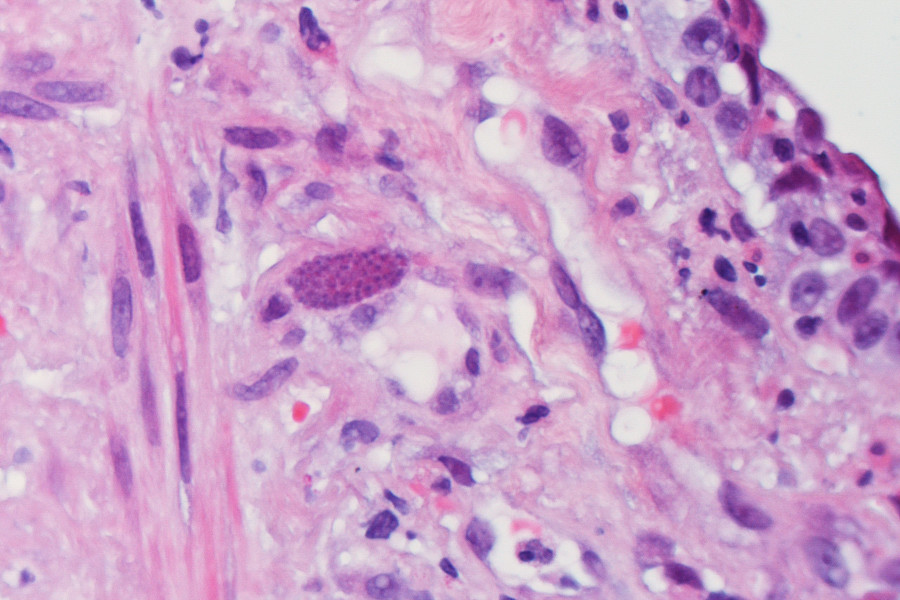Elucidating strategies developed by Toxoplasma gondii to orchestrate immune evasion and lifelong persistence in hosts
Identification of parasite factors able to subvert activities of the host, principally focusing on nuclear proteins such as transcription factors, and modulation of the epigenetic status of target genes, leading to reshape the host genetic program. We aim to study the modus operandi of these effectors and particularly their possible implications in immune evasion and parasite persistence. In this project, EDyP develop specific strategies to notably:
- characterize interactomes from selected candidates,
- compare in-depth proteomes of host cells infected with WT and mutant toxoplasma strains,
- analyse post-translational modifications on a global proteome scale (notably acetylome).
Collaborators
Host-pathogen interactions & Immunity to infections Team, Institute for Advanced Biosciences, Grenoble (Head : Mohamed-Ali Hakimi
EDyP project leader
Publications
- Azevedo, J., Picart, C., Dureau, L., Pontier, D., Jaquinod-Kieffer, S., Hakimi, M.-A., & Lagrange, T. (2019). UAP56 associates with DRM2 and is localized to chromatin in Arabidopsis. FEBS Open Bio, 9(5), 973–985. https://doi.org/10.1002/2211-5463.12627
- Braun, L., Brenier-Pinchart, M.-P., Hammoudi, P.-M., Cannella, D., Kieffer-Jaquinod, S., Vollaire, J., … Hakimi, M.-A. (2019). The Toxoplasma effector TEEGR promotes parasite persistence by modulating NF-κB signalling via EZH2. Nature Microbiology, 4(7), 1208–1220. https://doi.org/10.1038/s41564-019-0431-8
- He, H., Brenier-Pinchart, M.-P., Braun, L., Kraut, A., Touquet, B., Couté, Y., … Bougdour, A. (2018). Characterization of a Toxoplasma effector uncovers an alternative GSK3/β-catenin-regulatory pathway of inflammation. ELife, 7. https://doi.org/10.7554/eLife.39887
- Sindikubwabo, F., Ding, S., Hussain, T., Ortet, P., Barakat, M., Baumgarten, S., … Hakimi, M.-A. (2017). Modifications at K31 on the lateral surface of histone H4 contribute to genome structure and expression in apicomplexan parasites. ELife, 6. https://doi.org/10.7554/eLife.29391
- Gay, G., Braun, L., Brenier-Pinchart, M.-P., Vollaire, J., Josserand, V., Bertini, R.-L., … Hakimi, M.-A. (2016). Toxoplasma gondii TgIST co-opts host chromatin repressors dampening STAT1-dependent gene regulation and IFN-γ-mediated host defenses. The Journal of Experimental Medicine, 213(9), 1779–1798. https://doi.org/10.1084/jem.20160340
- van Rooyen, J. M., Murat, J.-B., Hammoudi, P.-M., Kieffer-Jaquinod, S., Coute, Y., Sharma, A., … Hakimi, M.-A. (2014). Assembly of the novel five-component apicomplexan multi-aminoacyl-tRNA synthetase complex is driven by the hybrid scaffold protein Tg-p43. PloS One, 9(2), e89487. https://doi.org/10.1371/journal.pone.0089487
- Braun, L., Brenier-Pinchart, M.-P., Yogavel, M., Curt-Varesano, A., Curt-Bertini, R.-L., Hussain, T., … Hakimi, M.-A. (2013). A Toxoplasma dense granule protein, GRA24, modulates the early immune response to infection by promoting a direct and sustained host p38 MAPK activation. The Journal of Experimental Medicine, 210(10), 2071–2086. https://doi.org/10.1084/jem.20130103
- Bougdour, A., Durandau, E., Brenier-Pinchart, M.-P., Ortet, P., Barakat, M., Kieffer, S., … Hakimi, M.-A. (2013). Host cell subversion by Toxoplasma GRA16, an exported dense granule protein that targets the host cell nucleus and alters gene expression. Cell Host & Microbe, 13(4), 489–500. https://doi.org/10.1016/j.chom.2013.03.002
Funding
- ANR HostQuest (https://anr.fr/Projet-ANR-18-CE15-0023, 2018-2022)
- ANR TOXOHDAC (https://anr.fr/Projet-ANR-12-BSV3-0009, 2012-2016)
- ANR APImiR (https://anr.fr/Projet-ANR-10-BLAN-1315, 2010-2014)
Image credit: Yale Rosen/Flickr.

